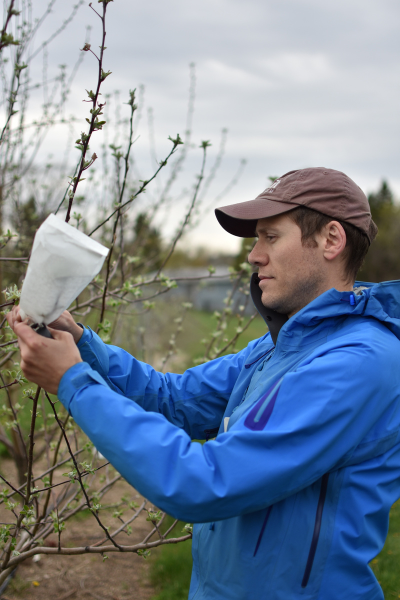Ancestry tests aren’t just for people or pets anymore. Thanks to DNA-based tracking, researchers at the University of Minnesota have finally traced the family tree of Minnesota’s favorite apple cultivar - the Honeycrisp. Sifting through thousands of DNA markers, Department of Horticultural Science researchers have unwoven the pedigrees of many of the U’s best apple cultivars, following the roots back to their European ancestors and the first days of the breeding program.
Apple breeding began at the University of Minnesota over a century ago in 1908 at the Horticultural Research Center (HRC), now a part of the Minnesota Landscape Arboretum. Since then, the apple breeding program has introduced 28 cultivars - including Honeycrisp, Zestar!®, and, more recently, those recognized by consumers as SweeTango®, First Kiss®, and Rave®.
In the program’s early years, researchers collected seeds from orchards around the state in hopes of finding new cultivars that could not only survive, but thrive in Minnesota’s signature harsh winters. Those records were then stored away in a fireproof vault at the HRC for years, but many contained incomplete or even unknown origins for multiple cultivars. Even though controlled breeding began in 1916 and continues today, non-standardized practices and fragmentary documentation left many ancestries up for interpretation. Now, with readily available DNA markers and an international collection of DNA information collected from years of academic advancement, a chance to solve the Honeycrisp-ancestry mystery finally seemed within reach.
Former University graduate student and postdoctoral researcher Dr. Nicholas Howard, now an apple breeder in the Netherlands, first developed ancestry tracking techniques using DNA markers to determine the true parents of Honeycrisp as part of his dissertation research. Through an exhaustive, collaborative effort with University apple breeders Jack Tillman, David Bedford, and Professor Jim Luby, Howard attempted a Herculean task - documenting not just the pedigree of the Honeycrisp, but all 28 University apple cultivars. He enlisted numerous national and international collaborators to assemble a database of DNA fingerprints for over 6,000 apple cultivars based on over 10,000 Single Nucleotide Polymorphism (SNP) markers. Additionally, he tapped Drs. Ana Poets and Kevin Silverstein of the Minnesota Supercomputing Institute to develop custom software that could help uncover genetic relationships between cultivars by tracking pieces of DNA shared by relatives through multiple ancestral generations.
“We compiled a database of apple cultivars from existing data and by genotyping thousands of cultivars in gene bank collections around the world through a large collaborative effort", Howard explained. “This, combined with new genetic techniques, allowed us to identify the specific parents, grandparents, and even more distant ancestors of UMN cultivars. Based on these analyses we could confirm, correct, or complete the parentage of 16 of the 22 cultivars introduced between 1920 and 1991''. These included not only Honeycrisp, but also two of the most prominent regional cultivars that preceded it - Haralson, introduced in 1922, and Fireside, introduced in 1943.
After extensive sleuthing, Howard uncovered two pervasive founding ancestors in Honeycrisp’s family tree: ‘Duchess of Oldenburg’ (a Russian cultivar introduced to Minnesota in the late 19th century) was an ancestor of overwhelming importance, appearing in the pedigrees of 27 out of 28 University cultivars; ‘Reinette Franche’, a French cultivar, appears not only in Honeycrisp’s family tree (as well as several other University cultivars’ family trees) but also that of many historically important cultivars and other commercially relevant modern cultivars, such as 'Gala' and 'Golden Delicious'.
Up next for the UMN apple breeding team and their collaborators? To explore the family tree even further, connecting thousands of cultivars across the globe. “Extended pedigrees will be very useful to breeders in determining future crosses,” Luby explained. “The more we know about their ancestry, the better we can predict the inheritance of desirable traits based on that ancestry.” The team is currently identifying genomic contributions from ‘Duchess of Oldenburg’ and ‘Reinette Franche’ to highlight regions to target for future selection. “This research won’t just help apple breeders,” Luby said. “DNA-confirmed ancestry provides a useful feature for nurseries and apple growers who highlight parentage when promoting their products.”
Not to mention satisfying customers’ curiosity as they bite into their favorite crispy treat.
Want to dive further into their research? Read the full article in HortScience.

